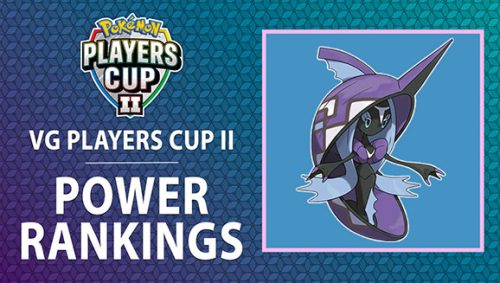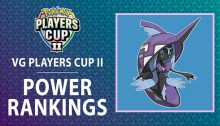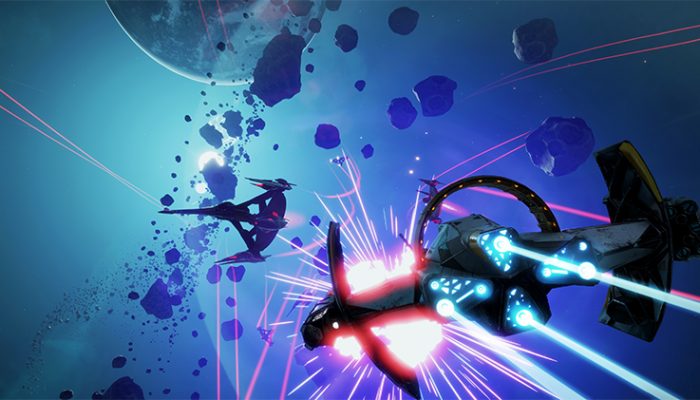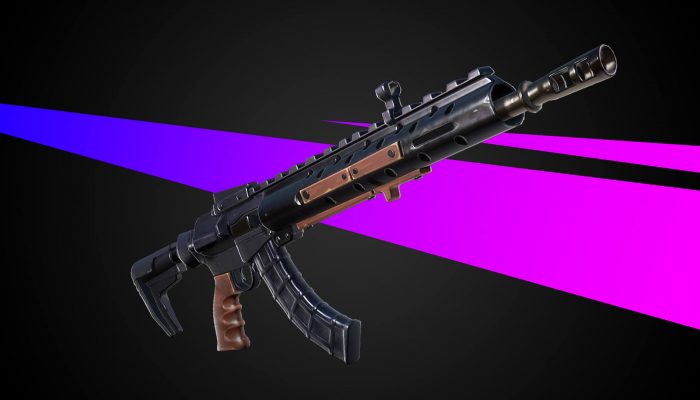 The first non-Legendary in the list, Metagross, ranks at #4.
The first non-Legendary in the list, Metagross, ranks at #4.
☆ NintendObs Weekly – Monday, November 30, 2020 – Sunday, December 6, 2020.

Players Cup II: Video Game Power Rankings
Our panelists identify the top 10 Pokémon to watch for when the Pokémon Players Cup II Region Finals stream starts on December 5.
Pokémon video game fans will not want to miss the Pokémon Players Cup II Video Game Region Finals matches streaming this weekend on Twitch.tv. This competition will be one of the first to permit the powerful Pokémon that have begun to appear in Galar since the launch of The Crown Tundra, leading to a massive shift in strategies. Invitations to the Global Finals are on the line, so you know the matches will be intense.
Before the stream begins, our Power Rankings panelists are here to help you catch up on the latest Pokémon and strategies. Many more Pokémon have entered the fray since the first Pokémon Players Cup Finals concluded—including newly discovered Legendary Pokémon, like Regieleki and Glastrier.
Read on to find out what to look for when the Pokémon Players Cup II Video Game Region Finals stream begins on December 5!
It’s no surprise to see Tapu Fini’s popularity given the versatility that made it popular in VGC formats of the past. With naturally high defensive stats and Misty Surge to block troublesome status conditions by creating Misty Terrain, Tapu Fini is a perfect partner for almost any team. Icy Wind gives it speed control, Heal Pulse allows it to heal the Pokémon on the field next to it, and Haze can erase the stat changes on both sides of the field. There’s a way Tapu Fini can support almost every possible partner it could be paired with in Series 7. Trainers can also prepare it for more offensive tactics; Calm Mind, Moonblast, and Muddy Water have proven themselves to be a consistent path to success for Tapu Fini on the battlefield. Tapu Fini is one of the most effective Water types in the metagame right now. If you want to use it on your team, it shouldn’t be hard to justify its spot.
— Gabby Snyder
Regieleki is, bar none, the fastest Pokémon ever, meaning much of its power is derived from going first in nearly every situation. The rest of Regieleki’s strength comes from its Transistor Ability, which boosts the damage of Regieleki’s Electric-type attacks. Regieleki can’t learn many attacks outside of its own Electric type, but it remains flexible as a lead Pokémon by using Volt Switch for massive damage on any opponent except for Ground-type Pokémon. Regieleki can then return to battle later to finish an opponent with a powerful Thunderbolt or Max Lightning. Some players choose to make use of a more supportive move set, having Regieleki hold the Light Clay item and use Electroweb, Light Screen, and Reflect to make sure Regieleki’s partner Pokémon can inflict as much damage as possible.
— Aaron Traylor
Glastrier is unique among Ice-type Pokémon—not only does it have immense attacking power, but its defensive stats are enough to make up for the weaknesses of the Ice type. Because of this combination, Glastrier is poised to be the most impactful Ice-type Pokémon of all time in VGC. Glastrier is commonly paired with Dusclops so it can attack first while Trick Room is in effect, which can enable several lines of play. Dusclops can activate Glastrier’s held Weakness Policy with a weak Brick Break or Rock Tomb. Alternatively, some players pair a Glastrier holding a Life Orb with a Dusclops that knows Haze, as dropping the Attack stat is a common counterplay to Glastrier. If the opposing team does not have a Pokémon with the Intimidate Ability or a way to stop Glastrier’s attacking power, you could see players lead with a Light Screen and Reflect user, such as Grimmsnarl or Regieleki, then plan on Dynamaxing Glastrier outside of Trick Room despite its Speed disadvantage.
— Aaron Traylor
Metagross is one of the Pokémon that has benefited the most from Dynamaxing this season. The Clear Body Ability and a large number of moves to choose from make Metagross such a well-rounded Pokémon. Tornadus has been a supportive Pokémon mostly used with Metagross, and the two have very good synergy. With middling Speed, Metagross needs to be supported with Speed control, and it could benefit from having its Attack boosted so that it can be a more threatening Pokémon. Tornadus takes care of both with Tailwind, doubling your team’s Speed, and Brutal Swing, activating Metagross’s Weakness Policy to raise its Attack by two stages. Most Metagross have been taught Ice Punch, Iron Head, and Stomping Tantrum as offensive moves, but I expect Rock Slide to be played more often to better handle Heat Rotom, a Pokémon commonly used to stop Metagross.
— Alex Gomez
With the introduction of The Crown Tundra, many Trainers are bringing Kartana back to their teams. Kartana boasts sky-high Attack and Speed stats along with a unique Steel and Grass typing, so it’s not hard to see why this Ultra Beast is a choice pick. With access to some of the best stat-increasing Max Moves—like Max Airstream, Max Knuckle, and Max Steelspike—Kartana offers great team support with Speed control, defensive support, and attack boosting, on top of Kartana’s pure offensive pressure. This Ultra Beast provides further benefit by easily handling Tapu Fini.
Kartana is incredible, and it’s something that players will need to have good answers for. Faster threats that can carry Fire-type special attacks are a nice starting point—or you could opt for a well-engineered Trick Room setup with a Fire type like Torkoal to lead the charge. However you approach Kartana, it’s not to be overlooked. With its phenomenal offensive potential and Beast Boost Ability, Kartana is an opponent that can quickly swing momentum in a game and snatch victory from your hands.
— Lee Provost
It’s not a surprise to see Therian Forme Landorus among the best Pokémon of the format. What makes this Pokémon so good is its wide range of available moves, which provides flexibility to any team. Most players give Therian Forme Landorus a Choice Scarf to increase its Speed beyond that of key opposing Pokémon. Some players instead have Landorus hold an Assault Vest, which—combined with Landorus’s Intimidate Ability—makes Landorus more challenging to defeat. The Life Orb has also become slightly more popular than in the past, as it can make Landorus’s damage output more threatening to opposing teams if Landorus is Dynamaxed, which can be a really good option later in the match. In addition, Regieleki’s rising usage has helped incentivize Trainers to add the Ground-type Therian Forme Landorus to their teams.
— Alex Gomez
Ever since the original release of its Hidden Ability, Intimidate, Incineroar has been one of the most reliable Pokémon in Double Battles. Its Intimidate Ability and key Fake Out attack have taken knocks with the introduction of a number of new mechanics in the Pokémon Sword and Pokémon Shield era. There are more Pokémon to consider now with the Competitive and Defiant Abilities that can really punish the use of Intimidate, and Abilities like Inner Focus and Oblivious now negate Intimidate. Fake Out, one of Incineroar’s best supporting options, has become a little less reliable with the introduction of Dynamaxing, too. When you weigh all these new interactions up, you soon see why some Trainers were unsure how effective Incineroar would be in this new environment.
But here we are early in a new format, and Incineroar is still among the most-used Pokémon. Even with so much working against it, Incineroar can act as support and provide pivoting opportunities for its Trainer and teammates in ways no other Pokémon can.
— Lee Provost
Trainers who enjoy using strategies with a balance of offense and defense often add Galarian Moltres to their team. Its fantastic defensive stats make it a tough Pokémon to knock out, and it takes advantage of this by boosting its Special Attack with a Weakness Policy or its Berserk Ability, both of which rely on taking damage and surviving. While this might deter opponents from targeting Moltres until they can be sure to knock it out, Moltres can punish that strategy by using Nasty Plot to bypass the need to take damage to increase its Sp. Atk. These traits make Galarian Moltres a powerful Pokémon to Dynamax, as the additional HP and extra effects from Max Airstream and Max Darkness further contribute to what this Moltres is all about: shrugging off attacks, raising its stats, and hitting back even harder.
— Justin Burns
Single Strike Style Urshifu has emerged as one of the most difficult Pokémon to deal with after the release of The Crown Tundra. The combination of Wicked Blow and Unseen Fist means it will rarely lose momentum against common defensive options that players use, like Intimidate or Protect. Usage of Urshifu differs from that of most offensive powerhouses—Trainers prefer to not Dynamax Urshifu in order to keep Wicked Blow’s guaranteed critical hit, something that makes this Urshifu a flexible Pokémon to include in many different strategies.
Where Single Strike Style Urshifu shines the most, however, is next to fast Pokémon that make good use of Max Airstream. Not only does Urshifu benefit from a Speed boost to potentially knock out Pokémon that are normally faster than it, but it can also use either Close Combat or Wicked Blow to deliver supereffective damage to every relevant Trick Room user—Porygon2, Dusclops, Cresselia, and Stakataka, to name a few. By preventing Trick Room from being used, Urshifu keeps Speed-boosting strategies from being disrupted.
— Justin Burns
Dusclops’s popularity going into the second Pokémon Player’s Cup is a curious one; in most past formats where Cresselia was allowed, it was Cresselia that would take the top spot as the most common Trick Room user over Dusclops. That’s not the case in Series 7 thanks to Glastrier, Dusclops’s slow, Ice-type partner. Glastrier is one of the many Pokémon in Series 7 that can utilize Dynamaxing and the Weakness Policy fantastically. Dusclops’s capability to learn Brick Break (which also helps against Gigantamax Lapras!) makes it the most suitable partner for Glastrier. Odds are that if you see one, you’ll likely see the other.
Dusclops is still a great support Pokémon regardless of Glastrier’s presence on your team. Will-O-Wisp is more important than ever with many physical attackers on the loose, Haze is amazing when facing opposing Glastrier or other Weakness Policy users, and alternating between Night Shade and Pain Split remains a consistent way to punish opponents for stalling out turns while waiting for Trick Room to expire. While it’s likely that Cresselia will become more popular and possibly take Dusclops’s spot in the top 10 in the future, for now Dusclops is here to stay, and it’s a Pokémon to be wary of.
— Gabby Snyder
Parting Shots
Lee Provost: With the Pokémon Players Cup II, I think we are going to see a number of the newly discovered Pokémon stamp their places as some of the strongest Pokémon available. Galarian Moltres is an incredibly strong Pokémon that I fully expect to see go very deep in the tournament. With support from Raichu’s or Togedemaru’s Lightning Rod Ability, Galarian Moltres can become extremely difficult for opponents to handle. Glastrier is another Pokémon that I expect to see do a lot of impressive things in this event, paired with Dusclops. The sheer defensive capabilities of this Wild Horse Pokémon combined with terrifying offensive pressure make this steed something every Trainer needs a solid game plan for.
If I were heading into this event, I would feel that Rock types could have a really good time to shine. My particular selection would be Regirock, because of its nearly unmatched Defense stat and how well it can perform under Trick Room. It feels like a Pokémon that Trainers could really use to their advantage against some of the more popular Pokémon we are seeing played at the moment, like Heat Rotom, Glastrier, Galarian Moltres, and the other Flying-type Pokémon that seem to have a little too much of an easy time right now.
Gabby Snyder: The Pokémon Player’s Cup II is occurring at the beginning of Series 7, when many Trainers haven’t had a chance to craft theories or test strategies much. Whatever team ends up winning the tournament will be the team to beat in the Battle Stadium mode for the remainder of the season, so if you’re watching from home, take notes and get creative! The return of so many beloved Legendary Pokémon brings back many strategies from the past and opens up many possibilities for the future—I can’t wait to see what you all come up with.
Alex Gomez: Santino Tarquinio became our Pokémon Players Cup winner by piloting Coalossal in a creative way. However, some players thought Coalossal wouldn’t have any room in the new format due to Pokémon like Therian Forme Landorus and Tapu Fini. It is true that Coalossal has a difficult time against these two, but that doesn’t mean Trainers can’t dream up a better build in order to have a better matchup against teams that challenge Coalossal.
Glastrier has been one of the additions to Coalossal team compositions, as it helps against some matchups Coalossal struggled with. People thought Coalossal wouldn’t be used anymore, but it looks like Trainers might still use it successfully!
Aaron Traylor: Despite its massive stats, Regigigas has had a hard time getting it going in tournaments because of its Slow Start Ability, which halves its Attack and Speed for five turns. But with the addition of Galarian Weezing’s signature Neutralizing Gas Ability—which negates the Abilities of the other Pokémon on the field—as well as the introduction of Dynamaxing, Regigigas finally got its act together in The Crown Tundra. Although opposing players might try to simply pick off the partner Weezing immediately or set up Trick Room to counter Regigigas, it isn’t that easy; Weezing can counter either approach itself with the moves Protect and Taunt, respectively. Regigigas can only be stopped by an opposing Dynamax Pokémon, by having the patience to knock Galarian Weezing out, or by having the ability to weather Regigigas’s powerful strikes.
Justin Burns: While Thundurus is one of the most feared Pokémon in the history of the VGC—and for good reason—it has been nowhere to be seen on top teams in recent years. Prepare for this to change with the new Ability Patch item, as Thundurus is now allowed to use its Hidden Ability, Defiant, competitively for the first time in seven years. While its counterpart Tornadus was the preferred Pokémon with Defiant in 2013, Thundurus has become the stronger of the two thanks to Dynamaxing letting it turn the normally sketchy Fly into the powerful Max Airstream. Thundurus can also use Max Lightning to help knock out most of the other common Max Airstream users and the ever-present Tapu Fini, and Thundurus has Max Knuckle to boost Attack for itself and its teammates.
Source: Pokémon.
At NintendObserver, the comments are on Discord.
Click on Community to learn more. 🙂
…
And if you’ve already got yours, click on Pokémon Sword & Shield for everything you need to know about the games. 😀


















